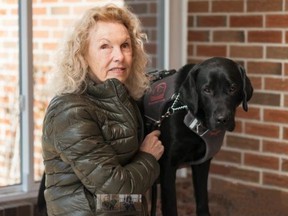‘Like somebody gave me the car keys back,’ Nobleton’s Bev Berger says

Article content
Bev Berger, blind since the age of 30, said going from using a cane to having a dog guide for the first time in 1989 was a revelation.
Advertisement 2
Article content
“To go from a white cane to four paws, honestly, it felt like somebody gave me the car keys back,” said Berger, 72, down the line from her home in Nobleton, north of Toronto.
Article content
Berger, who lost the sight in her left eye in a riding accident when she was 17 before becoming fully blind at 30 due to a retinal detachment, used a cane for the first seven years of her blindness. But she’s now up to her sixth dog guide, a black Labrador retriever named Jensen, who has been with her since mid-December.
Each dog guide has a working life expectancy of nine to 10 years and she previously had five yellow Labs named Reb, Nason, Kit Kat (her only female), Jasper and Lotus in consecutive order.
“When you’ve got a disability, people are sometimes a little bit leery, so they react to you through the dog,” said Berger.
Article content
Advertisement 3
Article content
“Like people will come up to me and go, ‘Hi! Oh, you’re a nice doggie. What’s your name?’ And then that person will go away and they think, ‘Oh, she’s just blind. That wasn’t so bad.’”
Recommended from Editorial
-

Staff at Virginia wildlife centre pretend to be foxes as they care for orphaned kit
-

Obese golden retriever Frannie wins hearts online during weight-loss journey
Berger said it takes about a year before handler and canine are truly in synch with each other.
“Everybody’s got little quirks, including dogs,” said Berger.
In fact, Berger’s pairing with Jensen makes her the client who has had the most dog guides with the Oakville-based Lions Foundation of Canada Dog Guides’ Canine Vision Canada program and Jensen is the 200th dog guide sponsored by Pet Valu (valued at $35,000).
Advertisement 4
Article content
“The continuity in my life has been dogs,” said Berger, who has two grown children with her late husband.
“After I received Jensen, I kind of felt like I won the lottery twice ’cause I came home with this great, young Lab and then I find out I’m the 200th sponsorship for Pet Valu, so ‘Hello!’ It just kind of made it fun. ”
In all cases, she was able to keep her dog guides after they retired, although Lotus died at age 10 after a visit to the vet revealed his spleen ruptured and his liver was bleeding.
“It just happened so quickly,” said Berger, sounding choked up.
RECOMMENDED VIDEO
Greg Clarke, the head instructor of Canine Vision Canada, said the program, founded in 1983, works with Labrador retrievers, golden retrievers and standard poodles (for those with allergies) from 15 or 16 months of age and onward.
Advertisement 5
Article content
It takes about five months of training for each animal.
“The dog has a job to do. It’s very serious. But when the dog is out of that harness, it is a pet,” said Clarke.
Clarke said there are between 22-25 dog guides trained annually by four instructors, who also work with between four to six clients with each coming in for about 18 days of training.
“There’s no cost to a client who comes to dog guides,” said Clarke. “It can be sponsored by one organization or two or three. We’re a non-profit that relies on public donations. We have a Pet Valu Walk for Dog Guides every year and it’s in the spring. And that’s a great fundraiser. There’s a lot of fundraising going on.”
Article content








